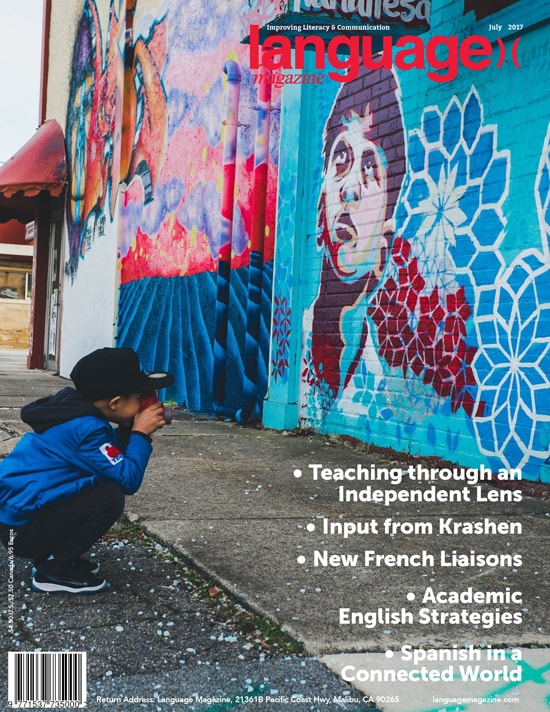 |
 I live in a multilingual universe, and this is how I imagine myself. This universe depends on being able to find the bonds and cross the bridges that connect us across our diversity. Language can divide us, but multilingualism helps us build the bridges to our united future. Because I am multilingual, I will be able to follow my dreams and enjoy the many dreams of my friends. The world will be mine, and there will be no limits to my dreams. Being multilingual will also allow me to communicate with many different people—people who think in different ways, who have their own beautiful dreams, and who are ready to illuminate me with their contributions.
I live in a multilingual universe, and this is how I imagine myself. This universe depends on being able to find the bonds and cross the bridges that connect us across our diversity. Language can divide us, but multilingualism helps us build the bridges to our united future. Because I am multilingual, I will be able to follow my dreams and enjoy the many dreams of my friends. The world will be mine, and there will be no limits to my dreams. Being multilingual will also allow me to communicate with many different people—people who think in different ways, who have their own beautiful dreams, and who are ready to illuminate me with their contributions.
What’s more, being multilingual makes me more intelligent. By learning different languages, my brain is transformed. For example, I can write in two languages. I can be more creative and solve problems more easily. All of this will help me make my dreams come true and create the bridges we need to be successful and to live in harmony and peace. And all these benefits apply to my family and community, too. Multilingualism helps us create a world that is more understanding and more capable of solving the big dilemmas that we face today and in the future.
Being multilingual gives us special power. We can use our words like weapons to defeat our problems. We can use our multilingual vocabulary in different ways: to explain, to convince, to read, to understand, to clarify, to interpret, to reveal, and to illustrate. We can be poets, and with our words, we can paint a new universe. In conclusion, I would like to share a poem with you that I wrote to communicate how important I feel it is to be multilingual.
Being Multilingual I Can Dream in the Colors of the World
Like a hummingbird that sings its scarlet song in the air,
I hear the voices of my community like a natural symphony of many rhythmic and marvelous languages.
My dreams are multicolored and multilingual.
Being multilingual is the best thing for my dear community.
Elegant and ecological, it provides us with an excellent education.
Smiling, we learn the benefits of multilingualism. Being multilingual makes every dream possible.
Welcome to my community and to a kaleidoscope of languages.
We inspire ourselves to be more intelligent.
With our imagination, we light up the nighttime darkness and invent new ways of living and sharing together.
No one can tell us that multilingualism isn’t worth it.
My generation is global, and our geography doesn’t have any borders.
United by our diversity, we know how to fight.
We write our own electric future.
With my family’s help, I speak better Spanish.
I hug the tasty syllables of my language. My heart is bigger when I speak Spanish,
and it dances in impressive celebration inside my body.
I hope it never stops dancing like that. I hope it never stops dreaming like that.
And every new language I taste brings new flavors to my life.
My community also dances and dreams with many brilliant languages.
Ideas paint the sky like the colors of a rainbow, forming the future world that waits for us, unique and shining. It’s a kaleidoscope,
a dramatic treasure that changes without end. United, my community promises us a good life.
It recognizes its responsibility to fight for opportunities for us.
Being multilingual has changed my future. Being multilingual, I have changed my future.
Being multilingual, I can dream in the colors of the world.
I become a rainbow of bright possibility.
Ser Multilingüe: Realizando Mis Sueños
Yo vivo en un universo multilingüe, y así me imagino. Este universo depende de poder encontrar vínculos y cruzar puentes que nos conectan a través de nuestra diversidad. El lenguaje nos puede dividir pero el multilingüismo nos ayuda a construir los puentes de nuestro futuro unido. Porque soy multilingüe, podré seguir mis sueños y disfrutar de los sueños numerosos de mis amigos. El mundo será mío, y no habrá límites a mis sueños. Ser multilingüe también me permitirá comunicarme con una gran diversidad de gente – gente que piensa de diferentes maneras, que tiene sus propios sueños bellos, y que está preparada para iluminarme con sus contribuciones.
Además, ser multilingüe me hace más inteligente. Al aprender varios idiomas, mi cerebro se transforma. Por ejemplo, puedo escribir en dos idiomas. Puedo ser más creativa, y puedo solucionar problemas más facilmente. Todo esto me ayudará a realizar mis sueños y a crear los puentes que necesitamos para tener éxito y vivir con armonía y paz. Y estos beneficios también se aplican a mi familia y a mi comunidad. El multilingüismo nos ayuda a crear un mundo más comprensivo y más capaz de resolver los grandes dilemas que enfrentamos hoy y en el futuro.
Ser multilingüe nos da un poder especial. Podemos usar nuestras palabras como armas para vencer nuestros problemas. Podemos usar nuestro vocabulario multilingüe de diferentes maneras: para explicar, para convencer, para leer, para entender, para aclarar, para interpretar, para revelar, y para ilustrar. Podemos ser poetas y con nuestras palabras pintar un universo nuevo. Para concluir, quisiera compatir con ustedes un poema que escribí para comunicar que tan importante me parece ser multilingüe.
Con Ser Multilingüe, Puedo Sonar con los Colores del Mundo
Como un colibrí que canta su canción carmesí por el aire, oigo las voces de mi comunidad como una sinfonía natural de muchos idiomas rítmicos y maravillosos.
Mis sueños son de muchos colores y muchos idiomas.
Ser bilingüe es lo mejor para mi comunidad querida.
Elegante y ecológica, ella nos provee una excelente educación.
Risueños, aprendemos los beneficios del multilingüismo.
Ser multilingüe hace possible cualquier sueño.
Bienvenidos a mi comunidad y al español.
Nos inspiramos a ser más inteligentes. Con nuestra imaginación, la oscuridad del anochecer se enciende e
inventamos nuevas maneras de convivir y de compartir. Nadie puede decirnos que no vale el multilingüismo.
Mi generación es global, y nuestra geografía no tiene fronteras.
Unidos por nuestra diversidad, sabemos luchar.
Escribimos nuestro proprio futuro eléctrico.
Con la ayuda de mi familia, hablo mejor español.
Abrazo las sílabas sabrosas de mi lenguaje.
Mi corazón es más amplio cuando hablo español, y
baila una danza de celebración impresionante dentro de mi cuerpo.
Ojalá que nunca pare de bailar así. Con cada idioma nuevo que pruebo, gozo de nuevos sabores en mi vida.
Mi comunidad también baila con muchos idiomas brillantes.
Ideas como los colores del arco iris pintan el cielo, formando el mundo futuro que nos espera, único y resplandeciente.
Es un calidoscopio, un tesoro dramático que cambia sin fin.
Unida, mi comunidad nos promete una buena vida.
Reconoce su responsabilidad de luchar para oportunidades para nosotros.
Con ser multilingüe, ha cambiado mi futuro. Con ser multilingüe, he cambiado mi futuro.
Con ser multilingüe, puedo soñar en todos los colores del mundo.
Me convierto en un arco iris de posibilidad brillante.
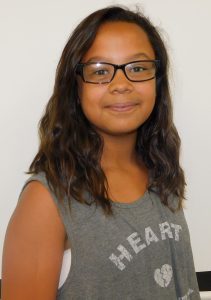 Liliana Sánchez is a 7th grade student in the Dual Language program at Walnut Grove K-8 School in Patterson, CA. She speaks Spanish and English and is learning Arabic. She is a writer, poet, dancer, and musician, and believes that the world is more beautiful with many languages and the arts. She has testified to both before the California legislature, and has provided motivational messages at state conferences to that effect.
Liliana Sánchez is a 7th grade student in the Dual Language program at Walnut Grove K-8 School in Patterson, CA. She speaks Spanish and English and is learning Arabic. She is a writer, poet, dancer, and musician, and believes that the world is more beautiful with many languages and the arts. She has testified to both before the California legislature, and has provided motivational messages at state conferences to that effect.
Liliana has traveled to four continents and plans to add a fifth by the end of next year. In the future, Liliana would like to learn additional languages and become a photographer. She says if the adults can’t get it together soon, she may be forced to become president!
 Pearson ELT has launched a new award to celebrate inspirational teachers. The global award will showcase teachers who have implemented innovative ways of teaching in their classrooms leading to improved learning outcomes, from the big innovations to the everyday.
Pearson ELT has launched a new award to celebrate inspirational teachers. The global award will showcase teachers who have implemented innovative ways of teaching in their classrooms leading to improved learning outcomes, from the big innovations to the everyday.


 Teachers looking for exciting authentic materials will be pleased to hear that Marvel Comics is teaming up with Italian publisher Panini Comics to translate some of its most popular stories into French, German, and Italian digital collections. Titles included in the translations are Deadpool, Civil War, Avengers, and Ms. Marvel. New titles will be released each month.
Teachers looking for exciting authentic materials will be pleased to hear that Marvel Comics is teaming up with Italian publisher Panini Comics to translate some of its most popular stories into French, German, and Italian digital collections. Titles included in the translations are Deadpool, Civil War, Avengers, and Ms. Marvel. New titles will be released each month.
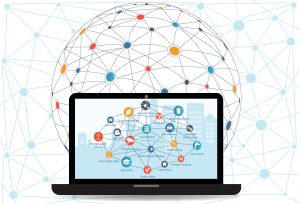 Learning Upgrade has launched a mobile app that enables English Language Learners (ELLs) to access their musical lessons on their own using any device, including phones and tablets, and is designed to improve students’ time on task by no longer limiting them to sitting in front of a computer.
Learning Upgrade has launched a mobile app that enables English Language Learners (ELLs) to access their musical lessons on their own using any device, including phones and tablets, and is designed to improve students’ time on task by no longer limiting them to sitting in front of a computer.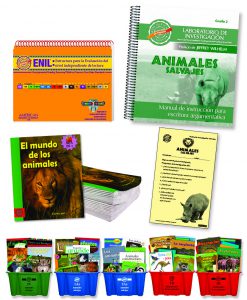 American Reading Company (ARC) offers a comprehensive core curriculum in English and Spanish that provides the materials equity and language parity districts are searching for.
American Reading Company (ARC) offers a comprehensive core curriculum in English and Spanish that provides the materials equity and language parity districts are searching for.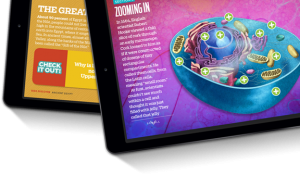 Kids Discover Online, an interactive digital library of science and social studies content, has added custom assessment capabilities to its platform. With the new tool, educators have full control to mix and match science and social studies materials to create, distribute, and assess custom quizzes, tests, and homework assignments directly within the platform.Teachers can choose from 5,000 questions covering more than 1,200 science and social studies topics. Question types include discussion prompts, short answer, multiple choice, and true/false. Each question can be customized, and different types of questions can be grouped together to create a variety of assessments ranging from short multiple-choice quizzes to longer mixed-question assessments.
Kids Discover Online, an interactive digital library of science and social studies content, has added custom assessment capabilities to its platform. With the new tool, educators have full control to mix and match science and social studies materials to create, distribute, and assess custom quizzes, tests, and homework assignments directly within the platform.Teachers can choose from 5,000 questions covering more than 1,200 science and social studies topics. Question types include discussion prompts, short answer, multiple choice, and true/false. Each question can be customized, and different types of questions can be grouped together to create a variety of assessments ranging from short multiple-choice quizzes to longer mixed-question assessments. Raytheon BBN Technologies has been awarded $4 million to provide automatic speech recognition, machine translation, text-to-speech, and optical character-recognition software licenses for one year to the Army’s Machine Foreign Language Translation System Program Office. This is the first large-scale fielding of the system.
Raytheon BBN Technologies has been awarded $4 million to provide automatic speech recognition, machine translation, text-to-speech, and optical character-recognition software licenses for one year to the Army’s Machine Foreign Language Translation System Program Office. This is the first large-scale fielding of the system.


 Today, the California State Board of Education unanimously adopted a revolutionary “English Learner Roadmap” to help California’s more than 1,000 local school districts welcome, understand, and educate the diverse population of students who are learning English.
Today, the California State Board of Education unanimously adopted a revolutionary “English Learner Roadmap” to help California’s more than 1,000 local school districts welcome, understand, and educate the diverse population of students who are learning English. I live in a multilingual universe, and this is how I imagine myself. This universe depends on being able to find the bonds and cross the bridges that connect us across our diversity. Language can divide us, but multilingualism helps us build the bridges to our united future. Because I am multilingual, I will be able to follow my dreams and enjoy the many dreams of my friends. The world will be mine, and there will be no limits to my dreams. Being multilingual will also allow me to communicate with many different people—people who think in different ways, who have their own beautiful dreams, and who are ready to illuminate me with their contributions.
I live in a multilingual universe, and this is how I imagine myself. This universe depends on being able to find the bonds and cross the bridges that connect us across our diversity. Language can divide us, but multilingualism helps us build the bridges to our united future. Because I am multilingual, I will be able to follow my dreams and enjoy the many dreams of my friends. The world will be mine, and there will be no limits to my dreams. Being multilingual will also allow me to communicate with many different people—people who think in different ways, who have their own beautiful dreams, and who are ready to illuminate me with their contributions. Liliana Sánchez is a 7th grade student in the Dual Language program at Walnut Grove K-8 School in Patterson, CA. She speaks Spanish and English and is learning Arabic. She is a writer, poet, dancer, and musician, and believes that the world is more beautiful with many languages and the arts. She has testified to both before the California legislature, and has provided motivational messages at state conferences to that effect.
Liliana Sánchez is a 7th grade student in the Dual Language program at Walnut Grove K-8 School in Patterson, CA. She speaks Spanish and English and is learning Arabic. She is a writer, poet, dancer, and musician, and believes that the world is more beautiful with many languages and the arts. She has testified to both before the California legislature, and has provided motivational messages at state conferences to that effect.